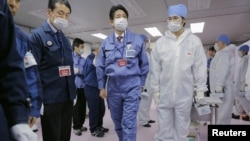TOKYO —
As Japan's newly installed prime minister toured the crippled Fukushima power plant Saturday, he made it clear he is set to review the previous government's plan to phase out nuclear power.
Japanese officials say Prime Minister Shinzo Abe decided to quickly visit the destroyed nuclear plant after his election to show he is serious about efforts to reconstruct Fukushima.
His first stop was a former soccer training center that is the staging ground for workers tasked with keeping things under control at the Fukushima nuclear power plant.
Abe told workers he is aware their task of decommissioning the facility is hard work and he wanted to thank them for their efforts.
The prime minister added his government will give the crews its full support.
Clad in a protective suit and wearing a face mask, Abe then went to Tokyo Electric Power Company's facility where three reactors suffered meltdowns after the region was struck by a magnitude 9.0 earthquake that triggered a massive tsunami on March 11th, 2011.
On-site, the prime minister remarked that the clean-up under way is “an unprecedented challenge in human history.”
Decommissioning is expected to take 40 years and $15 billion, plus the unknown cost of disposing of the plant's radioactive waste.
Radiation that spewed from the Fukushima plant contaminated communities and farmland, necessitating the removal of tens of thousands of people, and destroying many of their livelihoods. It is expected to be years, possibly decades, before people can live again in much of the area.
Public outrage prompted the previous Japanese government to pledge to phase out the country's reliance on nuclear power before the year 2040.
The Democratic Party of Japan, however, was swept out of power in parliamentary elections earlier this month. The return of Abe and his Liberal Democratic Party signal an impending reversal of the DPJ's policy.
Abe, during his visit to Fukushima, made it clear he is going to review that and spoke of the need for a “responsible energy policy.”
All but two of Japan's 50 reactors are offline for safety checks. That led to concern that the country, with scant natural resources, can provide enough affordable electricity if it does not rely on the nuclear plants.
Opponents of nuclear power cite lax safety standards, which they say left the Fukushima plant vulnerable to destruction in a natural disaster.
On the afternoon of Abe's visit, a magnitude 5.0 earthquake shook Fukushima.
Japan is one of the world's most seismically active countries. Some scientists say a number of other nuclear reactors in Japan appear to have been built directly above active quake faults.
Japanese officials say Prime Minister Shinzo Abe decided to quickly visit the destroyed nuclear plant after his election to show he is serious about efforts to reconstruct Fukushima.
His first stop was a former soccer training center that is the staging ground for workers tasked with keeping things under control at the Fukushima nuclear power plant.
Abe told workers he is aware their task of decommissioning the facility is hard work and he wanted to thank them for their efforts.
The prime minister added his government will give the crews its full support.
Clad in a protective suit and wearing a face mask, Abe then went to Tokyo Electric Power Company's facility where three reactors suffered meltdowns after the region was struck by a magnitude 9.0 earthquake that triggered a massive tsunami on March 11th, 2011.
On-site, the prime minister remarked that the clean-up under way is “an unprecedented challenge in human history.”
Decommissioning is expected to take 40 years and $15 billion, plus the unknown cost of disposing of the plant's radioactive waste.
Radiation that spewed from the Fukushima plant contaminated communities and farmland, necessitating the removal of tens of thousands of people, and destroying many of their livelihoods. It is expected to be years, possibly decades, before people can live again in much of the area.
Public outrage prompted the previous Japanese government to pledge to phase out the country's reliance on nuclear power before the year 2040.
The Democratic Party of Japan, however, was swept out of power in parliamentary elections earlier this month. The return of Abe and his Liberal Democratic Party signal an impending reversal of the DPJ's policy.
Abe, during his visit to Fukushima, made it clear he is going to review that and spoke of the need for a “responsible energy policy.”
All but two of Japan's 50 reactors are offline for safety checks. That led to concern that the country, with scant natural resources, can provide enough affordable electricity if it does not rely on the nuclear plants.
Opponents of nuclear power cite lax safety standards, which they say left the Fukushima plant vulnerable to destruction in a natural disaster.
On the afternoon of Abe's visit, a magnitude 5.0 earthquake shook Fukushima.
Japan is one of the world's most seismically active countries. Some scientists say a number of other nuclear reactors in Japan appear to have been built directly above active quake faults.





